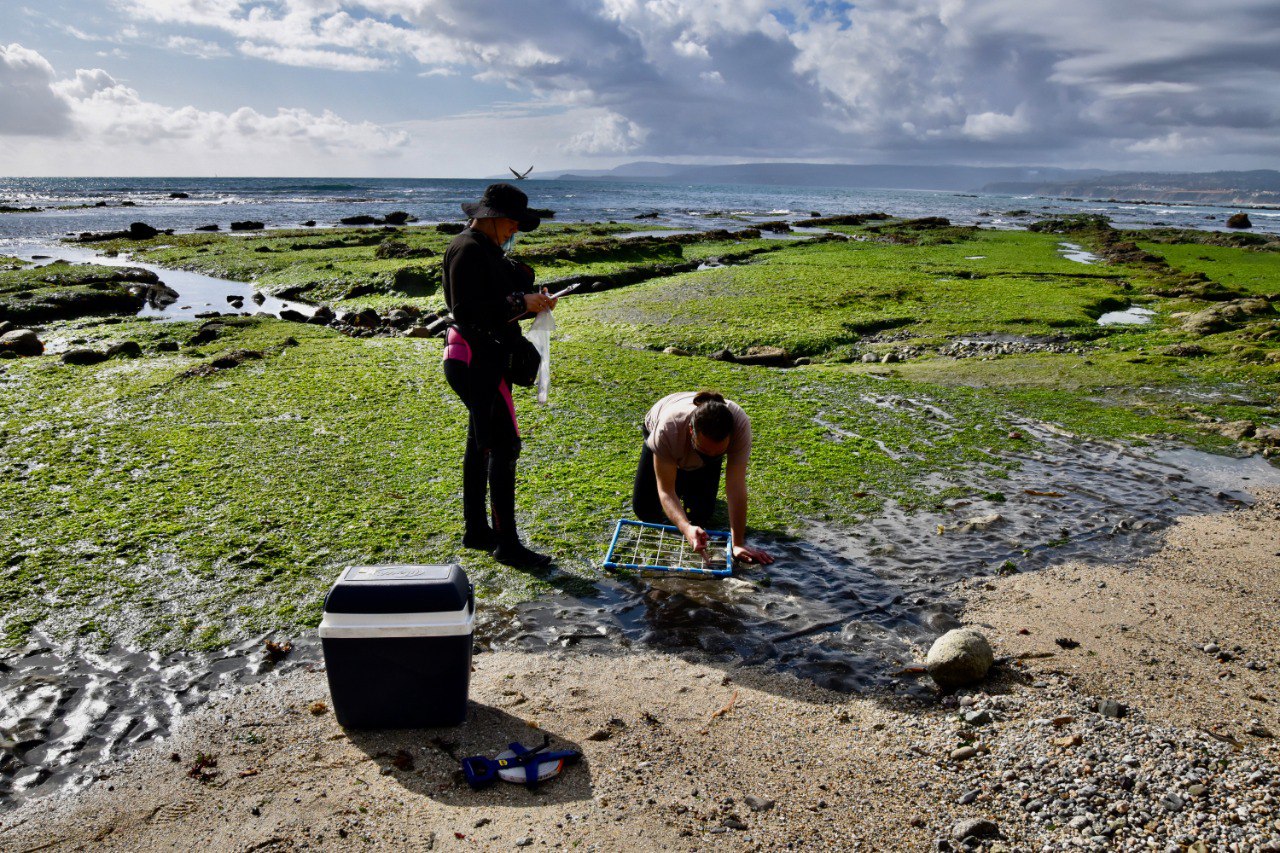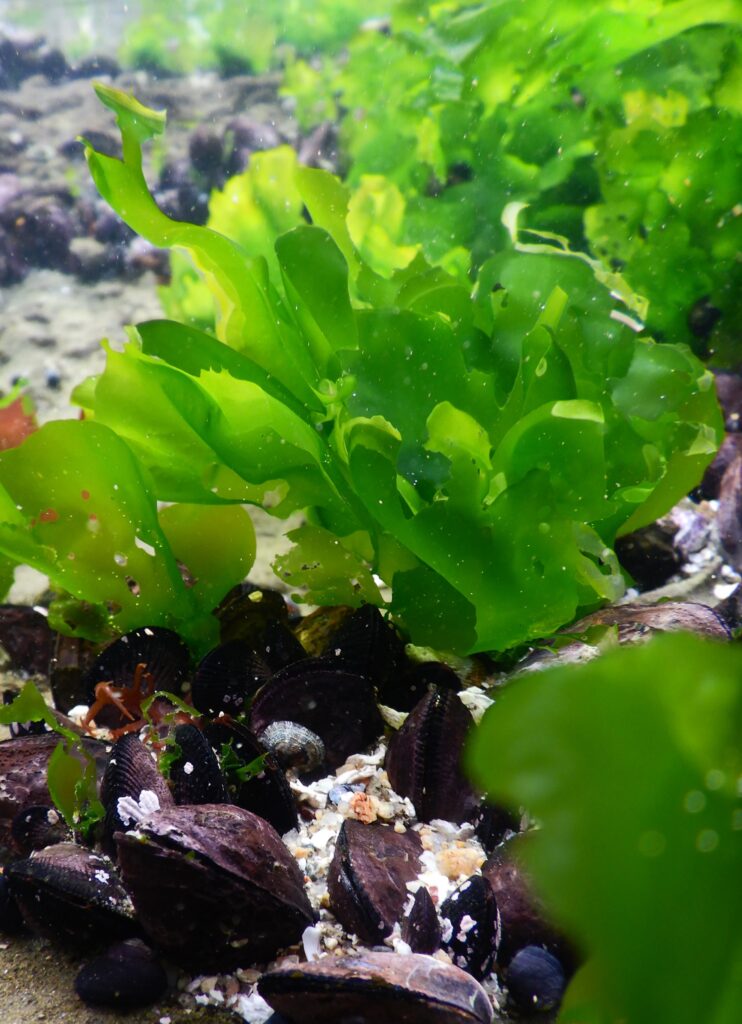
11 Jan Study associates Algarrobo’s “green tides” to natural conditions and environmental degradation
The research, carried out over three years, indicates that this phenomenon could be increased by changes in coastal sediments and sands and the absence of biological controls. It is estimated that the predominant algae could have been introduced to our coasts.
For over two decades, the beaches of Algarrobo Bay have experienced a proliferation of green algae—an event that has significantly impacted key activities in the area, such as tourism. Known as “green tides,” these algal blooms have caused large portions of the beaches and rocks to be covered by a green mat of algae, which produces unpleasant odors and makes it difficult to access the sea.
Although this phenomenon has been known globally for over 100 years, its frequency has increased in recent decades, raising concerns among coastal communities due to its effects on daily life, artisanal fishing, and especially tourism and recreation.
For this reason, beginning in 2021, researchers from various universities and scientific centers across Chile—led by the Millennium Institute for Coastal Socio-Ecology (SECOS), the UC Coastal Observatory Center, the UC Coastal Marine Research Station, and the Copas-Coastal Center—launched a research program to gather scientific evidence on the environmental conditions of Algarrobo Bay and their possible connection to the green tides affecting local beaches.
Carolina Martínez, director of the UC Coastal Observatory Center, explains that the issue of green tides is particularly concentrated in the southern sector of Algarrobo Bay, where the local population has seen its recreational and economic activities heavily restricted as a result.
“This was one of the main concerns we gathered from our work with communities in the area, which are affected by a series of complex problems such as coastal erosion, excessive urbanization, pollution, and a general loss of ecosystems.” Sergio Navarrete, researcher at the UC Coastal Marine Research Station and member of SECOS, adds, “This work provides a large amount of valuable information on various aspects of the marine ecosystem in Algarrobo Bay. It is scientifically robust and allows us to address at least some of the existing hypotheses in order to focus on the factors that may influence the proliferation of green tides and potential mitigation measures.”
Identifying the algae
After three years of research and multiple field campaigns, the conclusions of the report—delivered to the municipality and local community organizations in late December—dismiss some hypotheses and offer possible, though not definitive, explanations for the factors behind the green tides that have affected the bay for at least two decades.
One part of the study, coordinated by Loretto Contreras, a professor at Universidad Andrés Bello (UNAB) and SECOS researcher, together with Pilar Haye (UCN and SECOS) and an interdisciplinary team, discovered that five species of algae from the Ulva genus are present in these green tides. However, the predominant species is U. stenophylloides, which had not previously been described along Chilean coasts and may have been introduced into the bay.
“This collaborative work in identifying the species is a milestone for the South Pacific region and for Chile. It allows us to move forward with possible biomass control actions, to understand its origin and establishment, as well as its potential future use. We believe these could be introduced species, as there were no previous records. However, more collaborative work is needed to identify the species present along Chile’s coast—an ongoing project we plan to begin this year,” says Loretto Contreras, also from the CAPES Center.
Additionally, the proliferation of these algae may be explained by the nutrient levels along the Chilean coast, due to the phenomenon of coastal upwelling caused by southward winds, which bring cold, nutrient-rich deep waters to the surface. This phenomenon, common in various coastal zones of the country, drives high growth rates of macroalgal biomass and phytoplankton, promoting a steady and more noticeable summer growth of these green tides.
Interventions and coastal erosion
The study also suggests that the documented sand loss on Algarrobo’s beaches due to coastal erosion, may have affected Playa Los Tubos—one of the most impacted areas in the southern sector. The erosion could have transformed permanent sandy bottoms into ephemeral hard substrates that favor Ulva, as they are periodically covered by sand, eliminating other species. However, the researchers caution that there is not yet enough information to fully evaluate this hypothesis, and further investigation will be required.
The conclusions are further supported by the potential impact of the closure of the Cofradía Náutica area due to the breakwater that connects the mainland to the Islote Pájaro Niño, built in 1978. The results also suggest that, although the wave pattern has not been altered, the breakwater has slightly changed sediment transport patterns along the coast and in the Cofradía area, weakening the morphodynamics of the beaches in the southern sector of the bay.
“These results must be contextualized with studies on changes in sediment input caused by the high urbanization of ravines and coastal basins that drain into the bay, as well as the closure of estuaries, which also play a relevant role in the sediment dynamics of the beach,” explain Matías Gómez, professor at the University of Talca and Carolina Martínez, SECOS researcher and UC Geography academic.
This part of the study will continue through 2025, aiming to improve coastal modeling and integrate the effects of storm surges on coastal erosion and the impact of local ravine urbanization on sediment transport in the bay. “Those species that found favorable conditions for proliferation likely expanded in that area not only due to natural factors but also because of conditions created by human-driven degradation of coastal ecosystems. Another important point we believe is that the reduction of other species, including herbivores such as limpets, Chilean abalone (locos), sea urchins, invertebrates, and fish that are harvested from the area, has also contributed to the lack of control over these proliferating species,” adds Sergio Navarrete, also a researcher at COPAS-COASTAL.
Impacts of contamination
Another factor studied was the nutrient contribution from the ESVAL Submarine Outfall in Algarrobo, which had been speculated to influence the phenomenon. However, the findings concluded that it likely does not play a significant role in the persistence of the green tides in the southern part of the bay.
Despite this, the team of authors recommends implementing a monitoring program for coliforms in the bay’s filter-feeding organisms—both in rocky areas (such as mussels) and soft-bottom habitats (such as clams)—to better define the area directly impacted by organic matter and fecal coliforms from the outfall, and thus establish a safe shellfish harvesting zone for human consumption.
“Green tide problems of this kind around the world are extremely complex and have often been hastily attributed to causes that are not the true drivers. The information we are providing now makes it possible to move toward mitigation studies based on solid evidence. For that reason, we plan to hold a community information event in March to answer questions, explain some of the findings, and discuss how we can move forward or support mitigation-related efforts,” adds Navarrete.
Finally, another conclusion of the study recommends conducting research to identify Ulva species present in other bays in the country where green tides also occur, such as Coliumo Bay in the Biobío region. To do this, baseline studies are suggested, along with the establishment of permanent observation sites through a citizen science program to monitor green tides in Chile.
“It’s also important to establish simple measures to prevent the spread of these algae to other bays in Chile, and for that, we are collaborating with local sports clubs,” Navarrete concludes.






